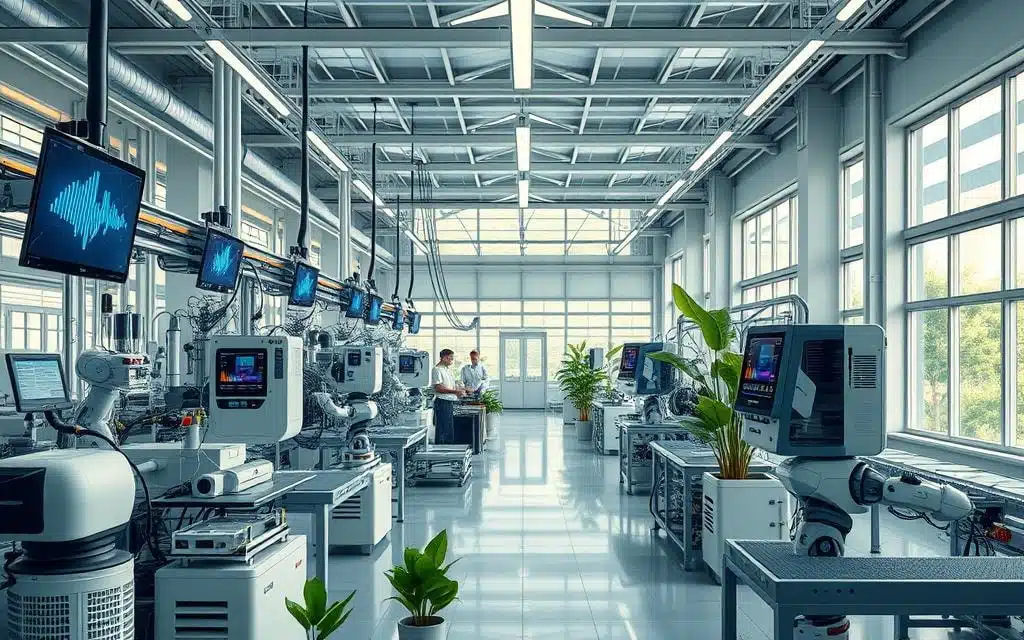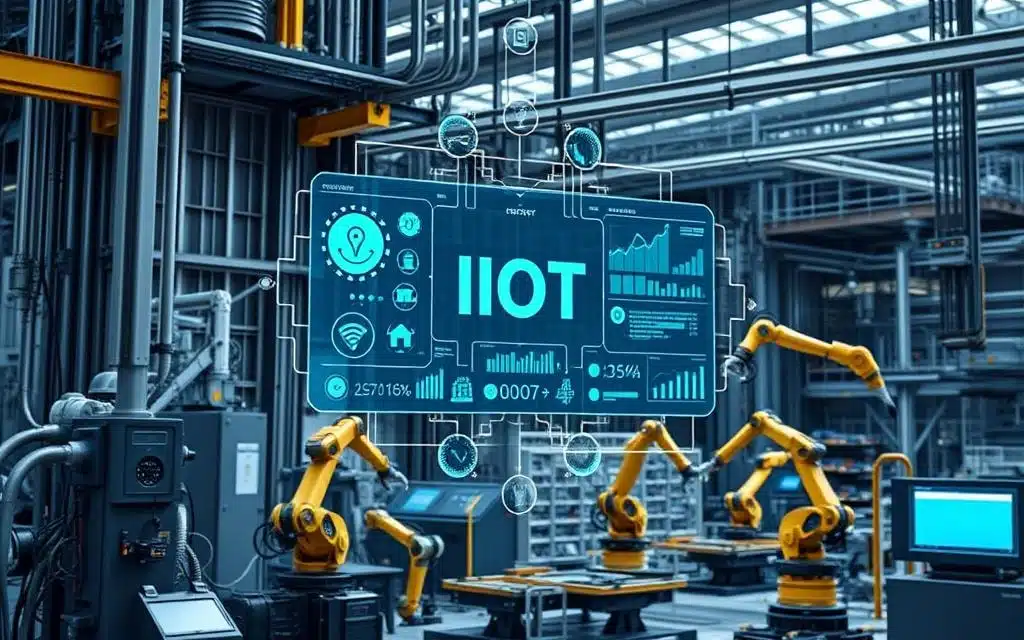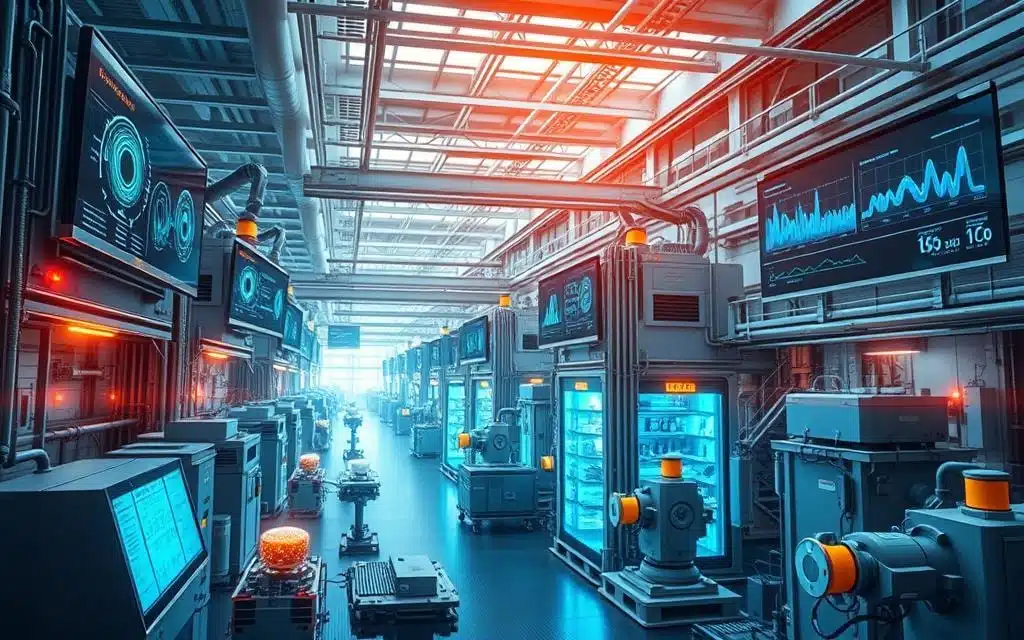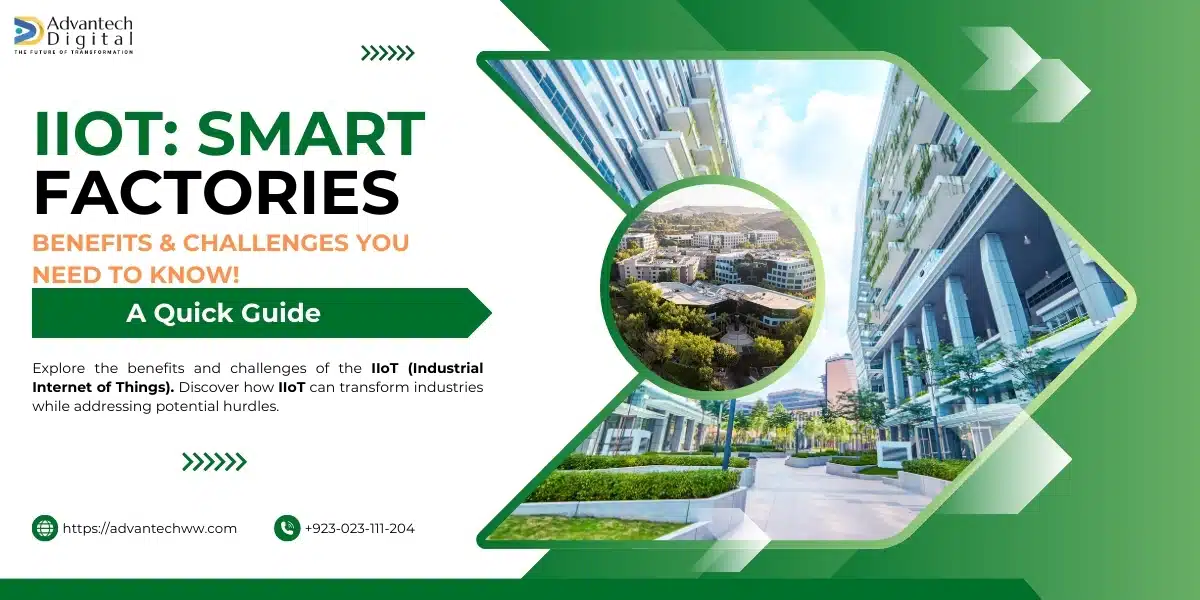The Industrial Internet of Things (IIoT) is changing manufacturing. Smart factories use advanced tech to transform production and business processes. IIoT differs from consumer IoT in many ways.
IIoT powers smart manufacturing, connecting factories for real-time data analysis. It links sensors, software, and machines to the internet. This shift automates processes and boosts efficiency.

Studies show IIoT-driven maintenance cuts costs by 30%. It also reduces downtime by 45%. Energy firms use IIoT to boost turbine output and cut costs. Logistics companies track trucks in real-time with IIoT. This leads to major savings and better service.
Yet, IIoT in smart factories has challenges. Data management and security are key concerns. Cyberattacks, malware, and device hacking pose threats. Companies must unite IT and OT experts. Strong security solutions are crucial to protect against cyber risks.
Key Takeaways
IIoT is a key component of Industry 4.0, enabling the transformation of traditional manufacturing processes into automated, data-driven operations.
Smart factories leverage advanced technologies like industrial automation, machine learning, and predictive maintenance to improve efficiency and reduce costs.
IIoT differs from consumer-focused IoT in its unique challenges and requirements, such as handling vast amounts of data and ensuring robust security measures.
Successful implementation of IIoT in smart factories requires close cooperation between IT and OT experts, as well as the integration of secure solutions to protect against cybersecurity threats.
The benefits of IIoT in manufacturing include increased operational efficiency, reduced maintenance costs, improved product quality, and enhanced service delivery.
What is Industrial Internet of Things (IIoT)?
IIoT connects machines, sensors, and devices to boost efficiency and reliability in industries. It enables machine-to-machine communication and big data analytics. By 2030, IIoT could generate $15 trillion in global GDP.

Defining IIoT & Its Role in Industry 4.0
IIoT drives Industry 4.0, the fourth industrial revolution. It covers robotics, medical devices, and software-defined production processes. Unlike consumer IoT, IIoT focuses on improving industrial devices and processes.
IIoT merges information technology (IT) and operational technology (OT). This enhances system integration and automation across various industries. These include agriculture, healthcare, manufacturing, transportation, and utilities.
Importance of IIoT in Smart Factories
The Industrial Internet of Things (IIoT) plays a crucial role in the development of smart factories, which are the backbone of the fourth industrial revolution. By integrating physical and digital systems, IIoT enables real-time data collection, analysis, and decision-making. This seamless connectivity leads to increased efficiency, productivity, and flexibility in manufacturing processes.
Smart factories equipped with IIoT technologies can optimize production workflows, predict maintenance needs, and improve product quality. For instance, real-time data from smart sensors allows for immediate adjustments in production lines, reducing waste and enhancing product consistency. Moreover, IIoT enables the creation of digital twins—virtual replicas of physical systems. These digital twins allow manufacturers to simulate, test, and optimize production processes without disrupting actual operations.
In essence, the industrial internet of things transforms traditional factories into intelligent, responsive environments that can adapt to changing demands and conditions, driving the fourth industrial revolution forward.
Key Components of IIoT Systems
IIoT systems have several key components for seamless connectivity and data-driven insights:
IIoT sensors and devices capture real-time data from industrial equipment and processes
Industrial connectivity technologies like Wi-Fi, cellular networks, and messaging protocols facilitate device communication
Edge computing processes data close to the source for improved efficiency and reduced latency
Cloud platforms provide scalable storage and powerful analytics capabilities
Digital twins create virtual replicas of physical assets for simulation and optimization
These components help industries gather and analyze large volumes of data quickly. This bridges the gap between production floors and offices for better decisions. iiot sensors enable devices to automate tasks and optimize asset use.
IIoT enhances interconnectivity, safety, and efficiency in the oil and gas industry, particularly in operations such as exploration, maintenance, and transportation.
Industry | IIoT Application | Benefits |
|---|---|---|
Automotive | Predictive maintenance | Reduced downtime, increased efficiency |
Agriculture | Precision farming | Optimized resource utilization, improved crop yields |
Oil and Gas | Asset tracking | Enhanced safety, streamlined operations |
Utilities | Smart grid management | Increased reliability, reduced energy waste |
The adoption of IIoT is expected to lead to an autonomous economy where supply meets demand efficiently and production processes are fully optimized.
Industries adopting IIoT face challenges like security concerns and legacy system integration. Robust security measures are crucial to protect sensitive data. These include multifactor authentication and end-to-end encryption.
With the right strategies, IIoT can revolutionize industries. It has the power to drive unprecedented growth and innovation across sectors.
The Difference Between IoT & IIoT
IoT and IIoT connect devices to the internet but serve different purposes. IoT focuses on consumer applications, enhancing everyday life. IIoT targets industrial sectors, optimizing operations and enabling data-driven decisions.
Consumer-Focused IoT vs. Industrial-Focused IIoT
IoT applications improve daily life and convenience. Smart devices enhance convenience for consumers by boosting energy efficiency and security in smart homes. They also play a vital role in the Industrial Internet of Things (IIoT) by aiding in automation and efficiency, facilitating real-time data collection and analysis for improved operational insights. Wearable health devices gather data on vital signs for informed health choices.
Connected vehicles offer real-time navigation, traffic updates, and entertainment services. These features make driving more enjoyable and efficient for consumers.

IIoT focuses on industrial applications like manufacturing, logistics, and energy management. It enables real-time monitoring, predictive maintenance, and autonomous operations. These features boost efficiency, productivity, and safety in industrial settings.
In manufacturing, IIoT can increase operational efficiency and reduce downtime. It also improves product quality and leads to significant cost savings.
Unique Challenges & Requirements of IIoT
IIoT systems face unique challenges and have stricter requirements than consumer IoT. IIoT security is crucial, as industrial networks handle sensitive data and critical systems.
Industrial protocols, like MQTT, ensure efficient and secure data transmission in IIoT networks. IIoT systems need precise and reliable sensors to prevent severe consequences in industrial environments.
IIoT networks handle larger data volumes than consumer IoT. Remote programming and customization are essential for adapting to specific industry needs.
Choosing between IoT and IIoT depends on specific needs, with IoT suitable for consumers and IIoT more beneficial for businesses and industrial operations.
IoT makes homes, cities, and devices smarter, enhancing everyday life. IIoT transforms industries by revolutionizing business operations and competitiveness.
IIoT’s unique challenges include advanced security, industrial protocols, and precise systems. These factors set it apart from consumer-focused IoT applications.
Real-World Applications & Use Cases of IIoT
The Industrial Internet of Things (IIoT) has revolutionized various sectors. It uses connected devices, sensors, and advanced analytics to boost efficiency. Industries can now optimize processes, cut costs, and improve overall performance.
Smart Manufacturing & Factories
IIoT enables smart factory automation, predictive maintenance, and asset tracking in manufacturing. Sensors and connected devices monitor equipment performance in real-time. This approach can reduce maintenance costs by 30% and downtime by 45%.
IIoT solutions also improve quality control and product traceability. These enhancements lead to higher product quality and increased customer satisfaction.

Energy & Utilities Sector
IIoT is vital in energy and utilities, enabling smart grids and energy management. Sensors monitor energy production and consumption in real-time. This helps utilities optimize distribution and detect potential issues quickly.
Smart meters and intelligent systems balance demand and supply better. They also encourage energy conservation. IIoT applications in this sector boost efficiency, safety, and reliability.
Automotive Industry
The automotive industry uses IIoT to improve production and supply chain management. Connected sensors monitor production lines in real-time. This ensures quick detection and resolution of issues.
IIoT solutions also enable predictive maintenance of equipment. This reduces downtime and improves overall equipment effectiveness. Asset tracking throughout the supply chain enhances inventory management and cuts lead times.
Transportation & Logistics
IIoT transforms transportation and logistics through real-time asset tracking and fleet management. GPS trackers and sensors monitor the location and status of assets. This visibility allows for better route planning and improved delivery times.
IIoT solutions also enable predictive maintenance of vehicles. This reduces breakdowns and maximizes fleet utilization. The table below shows key benefits of IIoT in this sector:
Benefit | Description |
|---|---|
Real-time Tracking | Monitor the location and status of vehicles and cargo in real-time |
Fleet Optimization | Optimize routes, reduce fuel consumption, and improve delivery timelines |
Predictive Maintenance | Detect potential issues in vehicles before breakdowns occur |
Enhance end-to-end visibility and optimize inventory management |
IIoT applications show its game-changing potential across industries. Smart factory automation and predictive maintenance boost efficiency. Asset tracking and energy management optimize operations.
Supply chain improvements increase productivity. These advancements help businesses thrive in the digital age.
Key Technologies Enabling IIoT
The Industrial Internet of Things (IIoT) is changing manufacturing with smart, connected factories. It uses advanced tech to gather data, analyze it, and provide useful insights.
Several key technologies work together in IIoT. They enable smooth data collection and analysis. This leads to actionable insights for businesses.
Sensors and Connected Devices
Industrial sensors are the backbone of IIoT systems. They capture real-time data from machines, equipment, and processes. These sensors include temperature, pressure, vibration, and position sensors.
Sensors provide vital info for monitoring and improving industrial operations. Connected devices, like iiot gateways, help send sensor data to the cloud or edge systems.
Cloud Computing & Big Data Analytics
Cloud computing is crucial in IIoT. It offers scalable infrastructure for data storage and analysis. Cloud-based iiot platforms help manufacturers collect and manage vast amounts of sensor data.
Data analytics tools use advanced algorithms to find valuable insights. This enables predictive maintenance, process optimization, and better decision-making.
Technology | Role in IIoT |
|---|---|
Edge Computing | Processes data close to the source, reducing latency and bandwidth usage |
Communication Protocols | Ensure reliable and secure data transmission between devices and systems |
Cybersecurity | Protects critical infrastructure and data from cyber threats |
Artificial Intelligence & Machine Learning
AI and Machine Learning algorithms are changing IIoT. They enable autonomous decision-making and predictive capabilities. These tools analyze vast amounts of data from industrial sensors.
AI and ML models can spot patterns, find anomalies, and improve processes in real-time. They’re key for predictive maintenance, reducing downtime, and boosting efficiency.
The convergence of sensors, cloud computing, big data analytics, and AI is driving the growth of IIoT, enabling manufacturers to unlock new levels of productivity, quality, and competitiveness.
Industrial IoT Architecture
Industrial IoT (IIoT) architecture refers to the structured arrangement of digital systems that provide network and data connectivity between sensors, IoT devices, data storage, and other layers. A typical IIoT architecture consists of the following layers:
Device Layer: This foundational layer comprises IIoT devices, sensors, and actuators that collect and transmit data from industrial operations.
Network Layer: This layer ensures connectivity between devices, enabling data transmission to the cloud or on-premise data centers through secure networks.
Edge Computing Layer: By processing data in real-time close to the source, this layer reduces latency and enhances decision-making capabilities.
Cloud Layer: Providing scalable storage, processing, and analytics capabilities, the cloud layer is essential for managing vast amounts of IIoT data.
Application Layer: This top layer delivers business logic, data visualization, and decision-making capabilities, turning raw data into actionable insights.
This multi-layered architecture ensures that IIoT systems can efficiently collect, process, and analyze data, driving improvements in industrial operations.
How IIoT Works
IIoT works by connecting physical devices, sensors, and machines to the internet, enabling real-time data collection, analysis, and decision-making. The process involves several key steps:
Data Collection: IIoT devices and sensors gather data from various aspects of industrial operations, such as equipment performance, environmental conditions, and production metrics.
Data Transmission: Collected data is securely transmitted to the cloud or on-premise data centers through robust network infrastructures.
Data Analysis: Advanced analytics and machine learning algorithms process the data to uncover insights, detect patterns, and predict potential issues.
Decision-Making: The insights and predictions derived from data analysis are used to make informed decisions, optimize processes, and improve productivity.
By leveraging real-time data and advanced analytics, IIoT enables industries to enhance operational efficiency, reduce downtime, and drive continuous improvement.
Role of IT in Industrial IoT
IT plays a crucial role in Industrial IoT (IIoT) by providing the necessary infrastructure, security, and analytics capabilities to support IIoT deployments. Key responsibilities of IT in IIoT include:
Network Infrastructure: IT ensures the provision of secure, reliable, and scalable network infrastructure to support the connectivity needs of IIoT devices and data transmission.
Cybersecurity: Protecting IIoT devices, data, and networks from cyber threats and attacks is a primary responsibility of IT. This includes implementing robust security measures such as encryption, access controls, and regular security audits.
Data Analytics: IT provides advanced analytics and machine learning capabilities to analyze IIoT data, uncover insights, and drive data-driven decision-making.
Integration: IT is responsible for integrating IIoT systems with existing business systems and applications, ensuring a unified view of operations and seamless data flow.
By fulfilling these roles, IT enables the successful deployment and operation of IIoT systems, driving efficiency and innovation in industrial settings.
Benefits of Implementing IIoT in Manufacturing
IIoT has transformed manufacturing, boosting efficiency, productivity, and quality. Connected devices and analytics help manufacturers excel and compete. The IoT manufacturing market is projected to hit $200.3 billion by 2030.

Increased Operational Efficiency & Productivity
IIoT greatly improves manufacturing efficiency and productivity. Manufacturing automation solutions streamline processes and reduce errors. Real-time monitoring allows quick adjustments based on data-driven insights.
This leads to higher throughput and better overall equipment effectiveness. IIoT systems cut cycle times and boost production line performance.
Predictive Maintenance & Reduced Downtime
IIoT enables predictive maintenance in manufacturing. Condition monitoring helps detect issues before breakdowns occur. This proactive approach minimizes costly unplanned downtime.
Predictive maintenance ensures efficient operations and extends asset lifespans. It also significantly reduces maintenance costs for manufacturers.
Improved Product Quality & Reduced Waste
IIoT enhances product quality and cuts waste in manufacturing. Advanced quality control systems detect defects in real-time. This allows for quick corrective actions.
IIoT-enabled traceability provides supply chain visibility. It ensures product quality and regulatory compliance. Process optimization leads to cost savings and happier customers.
These improvements minimize substandard products and boost scrap reduction. Manufacturers can achieve significant savings while satisfying customers.
Challenges & Barriers to IIoT Adoption
The Industrial Internet of Things (IIoT) offers many benefits, but it’s not easy to adopt. Companies face obstacles when trying to integrate IIoT solutions. Overcoming these hurdles is key to unlocking IIoT’s full potential.

Data Security & Privacy Concerns
Ensuring data security is a major challenge in IIoT adoption. A study found 60% of manufacturers worry about cybersecurity due to increased vulnerabilities.
Protecting industrial data from breaches is crucial. This involves using encryption, access controls, and regular security audits.
Integration with Legacy Systems
Combining IIoT solutions with existing legacy system integration can be tricky and expensive. 52% of companies struggle to integrate IoT devices with their current setup.
To fix this, businesses must invest in middleware solutions. Working closely with tech partners ensures smooth data exchange between new and old systems.
Skill Gaps & Workforce Readiness
IIoT systems need workers with the right digital skills. Yet, 70% of manufacturing companies lack employees with these abilities.
Addressing this gap is vital for smooth IIoT operations. Companies can use training programs, upskilling, and partnerships with schools.
Challenge | Percentage of Manufacturers Affected |
|---|---|
Lack of technical skills | 46% |
Integration and data challenges | 41% |
High costs | 38% |
Negative workplace culture | 36% |
Tackling these issues requires smart change management. Companies should promote innovation and involve all stakeholders. Creating clear IIoT implementation plans is also crucial.
By addressing data privacy, system integration, and workforce concerns, businesses can unlock IIoT’s potential. This drives digital transformation across industries.
“The key to successful IIoT adoption lies in a holistic approach that addresses not only the technological aspects but also the human and organizational factors involved in this transformative journey.”
Strategies for Successful IIoT Implementation
Implementing an IIoT strategy needs careful planning. Key aspects include clear objectives, ROI calculation, and choosing the right tech partners. These elements are crucial for a successful IIoT deployment.
Starting with pilot projects is vital. It helps validate IIoT solutions before scaling up. This approach allows for improvements based on real feedback. It also aligns implementation with overall business strategy.
A recent survey shows promising adoption rates. 74% of IoT professionals have deployed or are developing an IIoT strategy. This trend highlights the growing importance of IIoT in various industries.

Scalability: Ensure that the IIoT system can handle growing data sources without increasing costs.
Security and data privacy: Implement robust authentication, encryption, and tailored security approaches to safeguard sensitive data.
Integration with existing infrastructure: Prioritize seamless interoperability to enable effective data interchange among devices, sensors, and legacy equipment.
Data management and analytics: Establish processes for data cleansing, standardization, and storage optimization to ensure reliability and quality insights.
Return on investment assessment: Evaluate the benefits gained from increased operational efficiency and reduced costs against the expenses of establishing and maintaining the IIoT system.
Teamwork is key in IIoT implementation. IT, OT, and business teams must work together closely. Involving stakeholders early helps gather valuable insights and diverse perspectives on project needs.
Investing in workforce training is crucial. It helps bridge skill gaps and prepares employees for digital transformation. This preparation ensures a smooth transition to new technologies.
One of the largest shipping companies optimized routes using IIoT, receiving 743.5 million tracking requests per day and saving $50 million annually.
IIoT can greatly boost productivity. It automates tasks and enables predictive maintenance. Real-time notifications help minimize costly downtime. These features significantly improve human efficiency and operational forecasting.
Key Consideration | Importance |
|---|---|
Scalability | Handle growing data sources without increasing costs |
Security and Data Privacy | Safeguard sensitive data with robust measures |
Integration with Existing Infrastructure | Enable seamless data interchange among devices and legacy equipment |
Data Management and Analytics | Ensure reliability and quality insights through optimized processes |
Return on Investment Assessment | Evaluate benefits against expenses of establishing and maintaining the system |
Steps to Implement IIoT in Your Organization
Implementing IIoT in your organization requires a structured approach. Here are the steps to follow:
Define Business Objectives: Identify the specific business objectives and outcomes you want to achieve through IIoT implementation, such as increased efficiency, reduced downtime, or improved product quality.
Assess Current Infrastructure: Evaluate your current infrastructure, including network capabilities, existing devices, and applications, to determine readiness for IIoT integration.
Develop a Roadmap: Create a detailed roadmap for IIoT implementation, outlining timelines, budgets, and resource allocation. This roadmap should align with your overall business strategy.
Choose IIoT Technologies: Select the appropriate IIoT technologies, including devices, platforms, and analytics tools, that best meet your business needs and objectives.
Implement IIoT: Deploy IIoT devices, networks, and applications, and integrate them with your existing systems. Ensure that all components work together seamlessly.
Monitor and Optimize: Continuously monitor IIoT systems to ensure optimal performance, security, and analytics. Make necessary adjustments to improve efficiency and achieve desired outcomes.
Following these steps will help ensure a successful IIoT implementation, driving significant improvements in operational efficiency and productivity.
Common Mistakes to Avoid
When implementing IIoT, it’s essential to avoid common mistakes that can hinder success. Here are some common pitfalls to watch out for:
Lack of Clear Objectives: Not defining clear business objectives and outcomes can lead to unfocused efforts and suboptimal results.
Insufficient Infrastructure: Failing to assess and upgrade existing infrastructure to support IIoT can result in connectivity issues and data bottlenecks.
Inadequate Security: Neglecting the security of IIoT devices, data, and networks can expose your organization to cyber threats and data breaches.
Poor Data Analytics: Not providing advanced analytics and machine learning capabilities to analyze IIoT data can limit the insights and benefits derived from the system.
Inadequate Integration: Not integrating IIoT systems with existing business systems and applications can lead to data silos and inefficiencies.
By avoiding these common mistakes, you can ensure a smoother and more successful IIoT implementation, unlocking the full potential of IIoT technologies for your organization.
The Role of Data Analytics in IIoT
Data analytics is key in Industrial Internet of Things (IIoT). It helps manufacturers gain insights from device and sensor data. This leads to better operations, efficiency, and innovation across the value chain.
Collecting & Processing Industrial Data
IIoT systems generate huge amounts of data from various sources. This includes sensors, machines, and enterprise systems. Data acquisition is crucial for effective analytics.
Data must go through data cleansing to ensure accuracy and reliability. Advanced platforms offer features like real-time analytics and data visualization. These tools help organizations make data-driven decisions.

Deriving Actionable Insights for Optimization
Data analytics in IIoT provides insights for operational improvement. It uses techniques like predictive analytics and optimization algorithms. These methods uncover patterns, find inefficiencies, and predict potential issues.
Here are key areas where data analytics can optimize IIoT operations:
Predictive maintenance: Analyzes data to predict equipment failure and schedule maintenance proactively.
Process optimization: Monitors production, identifies bottlenecks, and improves resource allocation for better efficiency.
Quality control: Detects quality issues in real-time, allowing for quick corrective actions.
The impact of data analytics in IIoT is significant. Here’s a breakdown of different analytics types:
Analytics Type | Benefit |
|---|---|
Descriptive Analytics | Summarizes historical data for insights into operational performance and productivity |
Diagnostic Analytics | Uncovers root causes of issues, providing deeper insights into efficiency and failures |
Predictive Analytics | Forecasts future events, leading to increased efficiency, cost savings, and reduced downtime |
Prescriptive Analytics | Recommends optimal actions, optimizing resource allocation and driving continuous improvement |
Data analytics plays a pivotal role in optimizing operations, reducing costs, improving maintenance practices, and driving innovation in IIoT systems.
Data analytics unlocks IIoT’s full potential. It gives manufacturers an edge in the fast-changing world of Industry 4.0.
IIoT Security Best Practices
The Industrial Internet of Things (IIoT) is changing manufacturing. It’s driving Industry 4.0 and expanding the cyber threat landscape. A survey found 74% of manufacturers faced cybersecurity breaches recently due to unsecured IIoT devices.
Protecting critical infrastructure requires a multi-layered approach to IIoT security. This includes network segmentation, device hardening, encryption, and identity management. Embracing a zero-trust security model is also crucial.

Securing Industrial Networks & Devices
Maintaining visibility into the entire network and connected assets is vital. Companies with up-to-date asset inventories reduce cyber risk by 60%. Tools like AWS IoT Device Management help create accurate device inventories.
Network segmentation is a critical security measure. It can reduce cyber-attack impact on industrial control systems by 70%. This method isolates critical assets and limits lateral movement within the network.
Implementing Access Controls & Authentication
Securing access to IIoT devices prevents unauthorized entry and data breaches. Unique device identities and strong authentication are essential. Two-factor authentication can stop 80% of unauthorized access attempts.
Hardware-based security measures like Trusted Platform Modules (TPMs) enhance device security. Companies using TPMs see a 50% decrease in unauthorized access attempts. A zero-trust model treats every device and user as a potential threat.
Regular security audits and timely updates are crucial. Real-time monitoring systems cut incident response time by 65%. These practices help manufacturers protect sensitive data and ensure smooth smart factory operations.
The Future of IIoT & Smart Manufacturing
The manufacturing industry is evolving rapidly. IIoT and smart manufacturing are being shaped by emerging trends and innovations. Industry 5.0, 5G connectivity, and AI-powered automation are revolutionizing factory operations.
Industry 5.0 builds on industry 4.0, emphasizing human-machine collaboration. It uses IIoT and advanced technologies to create a more agile manufacturing ecosystem. This approach aims to improve responsiveness and customization in production.
Emerging Trends & Innovations
5G integration is set to transform manufacturing. Its high-speed, low-latency connectivity enables advanced IIoT applications. These include real-time monitoring, predictive maintenance, and remote control of manufacturing processes.
AI-powered automation is crucial for smart manufacturing’s future. It uses machine learning and analytics to optimize operations. This technology improves quality control and reduces downtime in factories.
Robots with machine vision can inspect products on assembly lines. They identify defects and make real-time adjustments. This enhances the overall effectiveness of manufacturing processes.
Technology | Benefits |
|---|---|
IIoT | Real-time data collection, predictive maintenance, enhanced workplace safety |
AI-powered automation | Optimized operations, improved quality control, reduced downtime |
Collaborative robots | Increased flexibility, enhanced human-robot collaboration |
Potential Impact on Jobs & Workforce
IIoT and smart manufacturing may automate some jobs. However, they also create new roles requiring different skills. Reskilling and upskilling workers is crucial for success in industry 4.0.
Collaborative robots, or cobots, are redefining the manufacturing workforce. They work alongside humans, enhancing productivity, flexibility, and safety. This human-machine interaction requires new skills and adaptability.
The future of manufacturing lies in the seamless integration of advanced technologies, human ingenuity, and a skilled workforce capable of leveraging the power of IIoT and smart manufacturing.
Embracing these trends is crucial for companies to stay competitive. Investing in IIoT, AI automation, and collaborative robots unlocks new efficiencies. This paves the way for a smarter, more connected manufacturing future.
Case Studies: Successful IIoT Implementations
The Industrial Internet of Things (IIoT) is changing industries worldwide. Real-world case studies show the benefits and ROI of IIoT solutions. These examples prove how companies use IIoT to improve operations and cut costs.
Amazon cut operations costs by 20% using IIoT solutions. Fanuc’s ‘Zero Downtime System’ nearly eliminated robotic system downtime. These iiot success stories show IIoT’s impact on efficiency and savings.
Worximity offers IIoT solutions for various manufacturing challenges. Their success stories cover dairy, food, bakery, meat, and rubber industries. They focus on downtime reduction and lean manufacturing tools.
Industry | Percentage |
|---|---|
Manufacturing | 37% |
Energy and Utilities | 16% |
Transportation | 16% |
Ports and Terminals | 9% |
Technical Services | 5% |
Education | 2% |
Government | 2% |
The table shows IIoT adoption across industries. Manufacturing, energy, and transportation lead the way. These sectors are experiencing major digital transformation due to IIoT.
Estimated $70 billion to be invested in IoT solutions in 2025 by global manufacturers.
This quote highlights the huge investments in IIoT by manufacturers worldwide. It shows growing recognition of IIoT’s potential to improve operations and competitiveness.
Key IIoT technologies include industrial switching (68%) and routing (40%). Cisco Ultra-Reliable Wireless Backhaul (40%), and industrial security (28%) are also important. These tools enable real-time monitoring and better network security.
IIoT solutions impact various areas of business. Production optimization (22%) and operational efficiency (19%) top the list. Infrastructure modernization (15%) and cybersecurity (10%) are also key benefits.
These iiot success stories show IIoT’s many advantages. They improve connectivity (28%) and safety (18%). IIoT also enables predictive maintenance (12%) and real-time monitoring (10%).
Conclusion
The Industrial Internet of Things (IIoT) is transforming manufacturing. It’s ushering in smart manufacturing and Industry 4.0 technologies. IIoT integrates advanced sensors, data analytics, and machine-to-machine communication to optimize operations.
IIoT implementation faces challenges like data security and legacy system integration. However, its benefits are undeniable. A Morgan Stanley study shows IIoT boosts efficiency through automation and continuous monitoring.
80% of businesses have already integrated IoT into their operations. This trend highlights IIoT’s importance for maintaining competitiveness in manufacturing.
The smart manufacturing future relies heavily on IIoT benefits. As Industry 4.0 technologies gain traction, smart factories become more common. Manufacturers embracing IIoT will enjoy increased efficiency and improved product quality.
Investing in IIoT and developing necessary skills is crucial. It ensures manufacturers stay competitive in the evolving industry landscape. The future of manufacturing belongs to those who harness IIoT’s power effectively.
FAQ
What is the Industrial Internet of Things (IIoT)?
IIoT uses smart sensors and connected devices to improve industrial processes. It combines machinery with digital tech to gather and analyze data. This leads to better decision-making and automation in manufacturing and other industries.
How does IIoT differ from consumer IoT?
IIoT focuses on transforming industrial operations, while consumer IoT enhances everyday life. IIoT involves more complex systems and higher precision requirements. It also uses specialized communication protocols and stricter security measures.
What are the key components of an IIoT system?
IIoT systems include sensors and connected devices for data collection. They use Wi-Fi and cellular networks for connectivity. Edge computing processes data locally.
Cloud platforms store and analyze information. Advanced analytics tools, like machine learning, derive insights from collected data.
How does IIoT enable predictive maintenance?
IIoT monitors industrial assets through sensors and connected devices. It analyzes data using machine learning algorithms. This helps predict equipment failures in advance.
Proactive maintenance can be scheduled, reducing unplanned downtime. This approach keeps operations running smoothly and efficiently.
What are the benefits of implementing IIoT in manufacturing?
IIoT boosts operational efficiency and reduces downtime through predictive maintenance. It improves product quality and minimizes waste. Real-time monitoring allows for faster defect detection.
Data-driven optimization of manufacturing processes leads to overall improved performance. This results in cost savings and increased productivity.
What are the main challenges in adopting IIoT?
Data security and privacy are major concerns due to the vast amount of sensitive information. Integrating IIoT with legacy systems can be complex.
Workforce skill gaps require training and upskilling. Effective change management is crucial for successful implementation. Overcoming these challenges is key to reaping IIoT benefits.
How important is data analytics in IIoT?
Data analytics is crucial in IIoT, turning raw data into actionable insights. It enables real-time monitoring and predictive maintenance. Advanced techniques like machine learning optimize processes.
Data-driven decision-making improves efficiency in industrial settings. This leads to better resource allocation and increased productivity.
What are some best practices for IIoT security?
Key practices include network segmentation, device hardening, and data encryption. Strong access controls and authentication are essential. Adopting a zero-trust security model adds an extra layer of protection.
Regular security audits and firmware updates maintain system integrity. Employee training is crucial for creating a security-conscious workplace.
How will IIoT shape the future of manufacturing?
IIoT will enable smart factories and Industry 5.0. AI-powered automation and human-machine collaboration will become commonplace. Some jobs may be automated, but new roles will emerge.
The manufacturing workforce will need different skill sets. This transformation will lead to more intelligent and efficient production processes.







8 thoughts on “Smart Factories IIoT Benefits & Challenges You Need to Know”
Comments are closed.